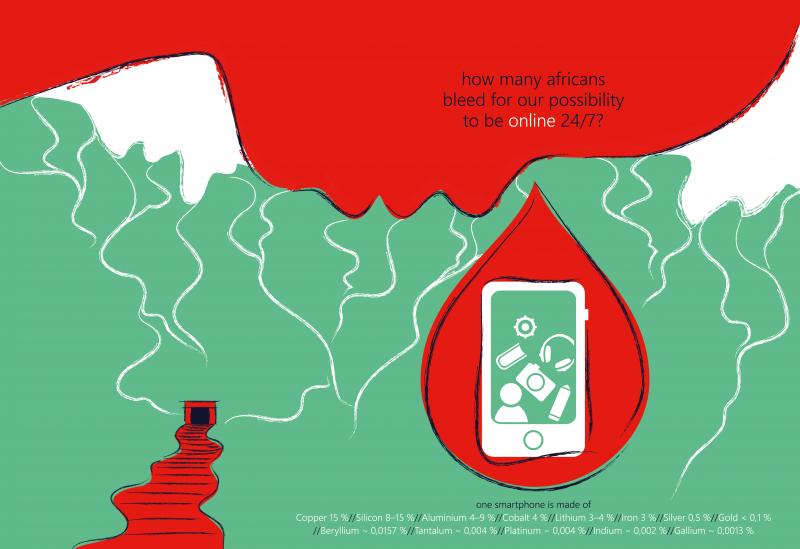Submitted by dilemma on

The price of progress
By Claudia Schett
Where the natural resources for our mobile phones come from
The market for electronic goods boomed during the last decades with no end in sight. Especially the trade with mobile phones exploded. In order to produce those metals like copper, gold and silver are needed. But where do the more rare resources like coltan come from? Under which circumstances are they extracted? How has the situation changed?
The electronic industry is in need of coltan, which is a conflict mineral. Besides of Africa it is currently also mined in Australia, Brazil and Canada. But none of them were as hardly discussed as the mining in the Democratic Republic of the Congo. Trading with coltan partly financed rebels and the civil war. In the coltan mines human rights violations like child labour, rape, torture and murder take place. After this abuses were discovered different coltan-importing countries and companies were searching for new solutions. But still in most cases the commercial routes are not comprehensible for customers. Anyway the consumers should be aware of those conflicts and search for their own way how to deal with this topic.
Today electronic goods like computers, digital cameras, mobile phones and many more contain the metal tantalum. It is obtained out of the very rare ore coltan (abbreviation for columbite-tantalite). Tantalum makes it possible to produce small but very efficient electrolytic capacitors. And because miniaturization is consistent as a trend in the electronic industry the characteristics of this resource are that attractive.
When the demand for coltan raised the mining in the Congo grew under very bad conditions. Not only people suffer from the cruelty of their employers, which are often groups of rebels, but also the nature loose. Coltan is extracted in nature secure parks, where gorillas and elephants were killed and forests cleared in order to build up the mining camps. Many of the mines are illegally. That makes it more difficult to get the situation under control.
As a reaction to this conditions and the pressure of the UN and others some companies in Europe have stopped trading with the coltan of Congo. Also the “Dodd-Franc Act” in the US, which was mainly made to gain more security for the financial system after the financial crisis in 2007, can be seen as an approach to the problem, but in need of improvement. It says that every company which is quoted on the stock exchange and deals with conflict minerals has to prove and publish that their metals are not related to regions with armed conflicts. This leads to the fact that big companies like Siemens doesn’t by coltan and other minerals from Congo at all. That not only the illegal mines, but also the legal and more reasonable ones are affected by this law, is the big disadvantage of it. Dealing with their mineral deposits is the basis of existence for a lot of people in this region.
Nowadays China is the biggest customer. With the coltan of Congo China produces electronic goods, which are exported to Europe and other countries. This is why the route of coltan is difficult to comprehend for customers. With the big companies, their suppliers and subsidiaries, the global ex- and import, it is not easy to know where the resources of a single mobile phone comes from. Even if people could be sure about the origin of the coltan there are other metals, for which also the question of sustainability and fair production arises.
Mobile phones and other electronic achievements have become an important part of our daily life. It would be very unrealistic to tell people not to buy mobile phones anymore. But there are some options for everybody to improve the situation. For me the very first step is information. When people don’t know about those processes how should they care? So people who know about this issue should not be afraid to tell their friends and family how precious their electronic stuff is, which effort people all over the world have put into them.
This leads me to the next step, which is to see such goods not as many commercials want us to see them, as disposable article. Advertising often works through emotions and creates needs. This is what people should be aware of. Because if your mobile phone is still working fine, why buying a new one? Is being up to date with the latest smartphone really that important?
Another option is recycling. The rare metals like tantalum, indium and gallium are more complex to recycle than copper or gold. This makes it even more important, that everybody recycles mobile phones. Because then it would be also more economic for a company to really extract those metals and use them again. One single smartphone only consists of about 0,004% tantalum. But if we look at a study of the ITU (International Telecommunication Union) which predicts that this year there will be seven billions of mobile phones in the world, then recycling is really worth it.
The last thing I could recommend, is to support companies which are searching for alternatives. Yet there is no phone which is produced fair for 100%. Even the “Fairphone” cannot claim to use only conflict-free minerals, but tantalum and tin they bought from legal, conflict-free mines in the Congo.
All in all we should not look for a change overnight, but see every step we take towards fairness und sustainability as a chance and a statement. With all the things that are going wrong we should never give up hope.
Sources:
http://www.zookrefeld.de/uploads/media/handys-coltan-gorillas_1_.pdf
http://www.vice.com/de/read/der-blutige-fingerabdruck-von-coltan


